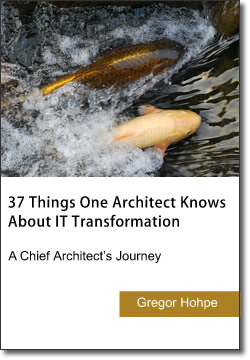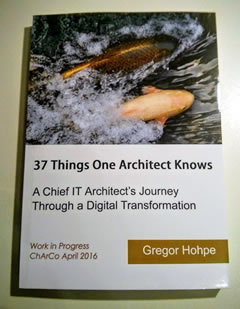 Hi, I am Gregor Hohpe, co-author of the book Enterprise Integration Patterns. I work on and write about asynchronous messaging systems, distributed architectures, and all sorts of enterprise
computing and architecture topics.
Hi, I am Gregor Hohpe, co-author of the book Enterprise Integration Patterns. I work on and write about asynchronous messaging systems, distributed architectures, and all sorts of enterprise
computing and architecture topics.

Find my posts on IT strategy, enterprise architecture, and digital transformation at ArchitectElevator.com.
About two years ago, I revived the ramblings from a four-year hibernation. Upon resurrection, the ramblings started to take a broader scope, including not only messaging, conversations, and patterns, but also communication and IT architecture topics. The new topics were a natural reflection of my new role as Chief Architect in a massive IT transformation and after a little while I decided that they deserve their own channel, so I wrote a book about it.
IT transformation has become quite a popular word as traditional enterprises are coming under pressure from "digital disruptors" who innovate faster, at lower cost, and don't have to deal with legacy. Such transformations often focus on IT organizations and systems architecture as enterprises understand that IT is no longer a necessary evil, but a critical business enabler. Sadly, an IT department that has been run as a cost center for years or decades while valuing stability over change, is not well prepared to provide business agility and flexibility to the business.
IT architects can and must play a critical role in such transformations because they combine the technical, communication, and organizational skill to organize and apply information technology for measurable business benefit. They understand what "being agile" and "DevOps" really mean and what cultural, organizational, and technical changes are needed to implement them. They know that shoving random monoliths into a Docker container doesn't make them cloud-native. And they can weigh the risk of new technology against the need to transform. It's no surprise then that software and IT architects have become some of the most sought-after IT professionals around the globe.
The architects' job is not an easy one, though: they must maneuver a rigid organization where IT is still seen as a cost center, where operations means "run" as opposed to "change", and where middle-management has become cozy neither understanding the business strategy nor the underlying technology. On top of all this, the affected organizations are often still quite profitable, reducing their appetite for change: non-IT-savvy management may be quite content with the status quo and actively resist change as that will expose their ignorance. Vendors like to introduce new technology, but are also generally happy having their clients not too IT savvy lest they no longer require services.
 To assist architects who are involved in an IT transformation or are contemplating
taking a bigger role, I decided to write down my experiences into a collection of
short essays of about 1500 - 2500 words, slightly longer than the average rambling. I absorbed a handful of ramblings into the book, including the classic Starbucks rambling, but edited and expanded all of them to make them fit for print publication.
To assist architects who are involved in an IT transformation or are contemplating
taking a bigger role, I decided to write down my experiences into a collection of
short essays of about 1500 - 2500 words, slightly longer than the average rambling. I absorbed a handful of ramblings into the book, including the classic Starbucks rambling, but edited and expanded all of them to make them fit for print publication.
I structured the topics into 5 sections:
To set myself a concrete target, I decided that I would write 37 essays on the topic and named the book 37 Things One Architect Knows. Why 37 things and not 36 or 38? 37 is a nice prime number with a mellow sound to it. The title is also a spoof on O'Reillys 97 Things books, to which I contributed.
Borrowing from the ramblings, I gave the essays catchy titles like:
The writing process was fairly fast just over 72,000 words written from February until end of June, in just 5 months. That's almost 500 words a day, or about 2 "things" a week. Not quite on par with the popular 750 Words thing, but also without the motivating metrics. I guess the somewhat annoying Island Paradise Blogger dude (link intentionally omitted) would have written 70,000 words in just a week... ah well. I'll try it next time I am in Phuket. Actually, I did write 2 chapters while in Mai Khao so maybe there is something very inspiring about Thailand.
 You can buy the e-book DRM-free in epub, mobi, and pdf formats at leanpub.com/37things. There's also a free preview.
You can buy the e-book DRM-free in epub, mobi, and pdf formats at leanpub.com/37things. There's also a free preview.
When writing a book about the digital, fast moving world, publishing an e-book seems most appropriate. Leanpub is a nifty little platform that allows you to write your book in markdown with a local GIT workflow and Dropbox synchronization. They also allow readers to chose the price they want to pay, making them an interesting mix of a publishing platform and Kickstarter.
You can also buy printed copies at Lulu(Europe) or Amazon(Worldwide). Feel free to contact me for volume discounts, e.g. for a lecture or workshop. I also provide copies to workshop participants.
While both Enterprise Integration and Enterprise Transformation are important enterprise-level topics, I figured that the audiences will be somewhat distinct. I have therefore given my thoughts on digital transformation and IT strategy its own home, ArchitectElevator.com. Go and have a look.
Communication and organizational transformation skills are difficult to learn from books, so I offer 2-day workshops , which include many exercises.
What will happen to the ramblings now? 37 Things started out as the procrastination project for EIP 2. Now that I have the 37 things out of my system, I will start rambling and writing about conversation patterns again.